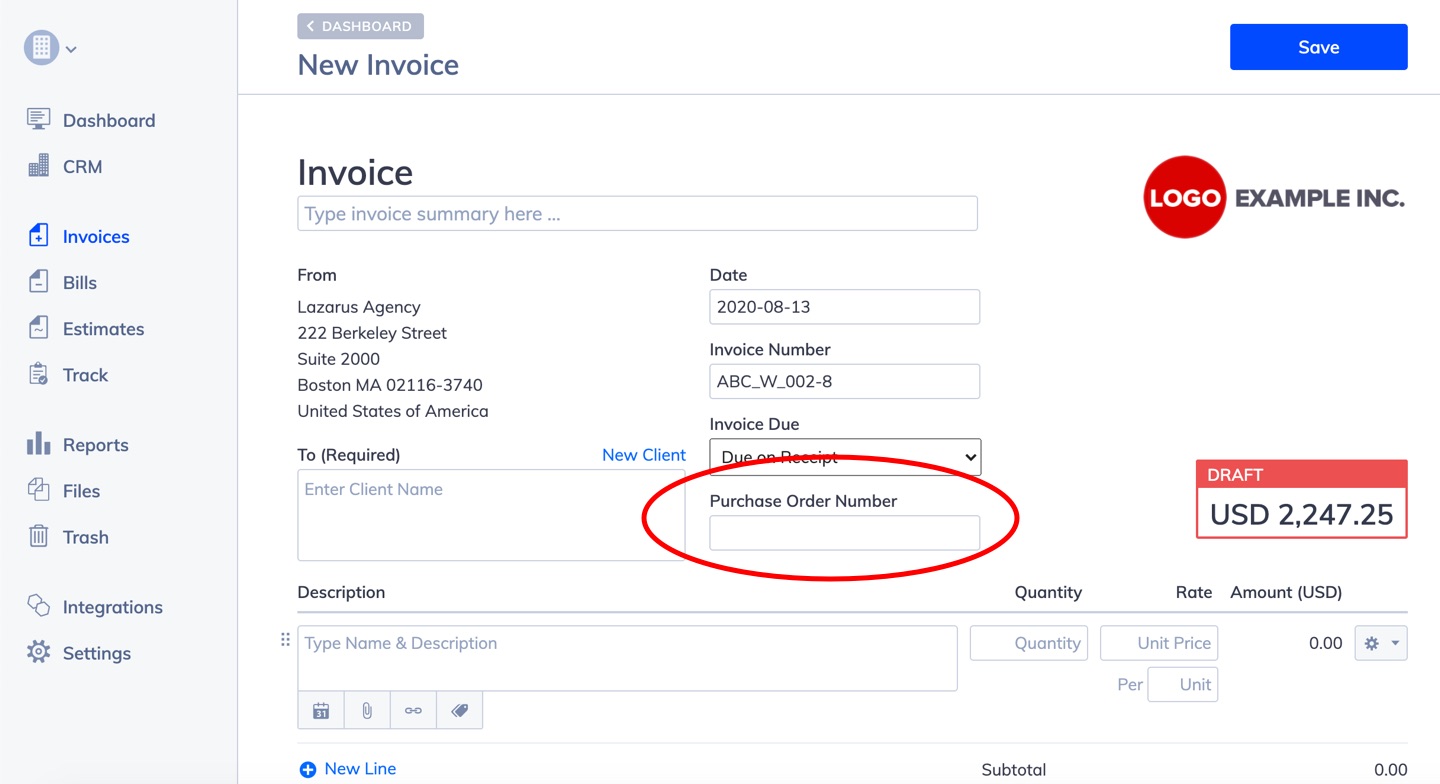Purchase Order vs Invoice — What are the Differences?
In most cases, the creation of a purchase order is your first step for a business transaction. The buyer issues a purchase order, which allows the seller to provide a service or product at a particular price. Then, the invoice is considered the bill and is given to the seller once the service or product has been completed or delivered, with appropriate payment terms such as due upon receipt. Both documents are essential for finance departments and small business owners. Therefore, it’s a good idea to learn about both options and why they’re so important in the accounts payable domain.

What is a Purchase Order?
A purchase order or PO is your official confirmation for the order. The document is sent by the purchaser to the vendor, authorizing the purchase.
What is an Invoice?
The invoice is a document that requests payment for the purchase. Invoices are sent to the purchaser from the vendor. What is the Difference Between Purchase Order and Invoice?
A better way to manage your finances
With Hiveage you can send elegant invoices to your customers, accept online payments, and manage your team — all in one place.
The primary difference between purchase order and invoice is how they are used. You need confirmation that the order has been placed from the PO. Invoice documents help request payment for the order. Invoices are provided by the vendor to the purchaser, and they are sent when the order is complete, and per the payment terms.
Similarities Between Purchase Orders and Invoices
Though the documents are different, there are a few similarities between them. Of course, the purchase order of anything is a legally binding contract, as is the invoice. Therefore you’ve got an agreement between the vendor and purchaser, and certain actions are required as specified in these documents.
Both documents include relevant order details, as well as pricing and mailing information. The invoice consists of the invoice number, as well as any payment adjustments (discounts/credits), vendor contact information, the total amount due for the vendor, and a payment schedule. The purchase order (PO) number might also be provided for reference.
What Is a Purchase Order Number?
The purchase order number is clearly marked on the purchase order and is a unique number. You can only use it once per order, so this purchase order number is different from any other. Some accounting software automatically generates the purchase order number when the new order is prepared. This number can be referenced by the seller and client throughout the process of buying. Then, the seller uses it to send the invoice later.
What Information Should You Include on Your Purchase Order?
Though each software is different, most purchase orders contain similar information. This includes:
- Purchase Order Number
- Today’s Date
- Quantity of Services or Goods
- Description of Services or Goods
- Vendor Contact Information (email address included)
- Prices
- Special Notes
- Tax Information
Why Are Purchase Orders Important?
A purchasing order is essential for the following reasons:
Legally Binding
It’s the official agreement between the seller and buyer. In a sense, it means that both companies (or the company and individual) authorize this purchase. With a purchase order for goods and services, you might not need a separate contract for the particular transaction.
Easier to Track
Business owners prefer to use the purchase order as a tool throughout the transaction. You can easily reference the purchase order number to determine where the item is and when it should arrive at the buyer's location.
Simplifies Invoicing
The seller can quickly reference a PO number on the invoice, showing that the services or products provided are pre-approved.
How to Use the Purchase Order
As a business owner, it is up to you to use things that make it easier to do your job. Your website likely has terms and conditions, so it makes sense that you use invoices and purchase orders. This shows what the buyer owes, the due date for payment, and delivery time, as well. When you create a template for a purchase order, it saves you a lot of time.
Businesses usually have templates, so it is easy to send and receive the purchase order. Both parties get the data they want and need so that they can focus on the purchases and gathering together the products to send.
When you talk to someone about providing goods or services, you probably have lengthy calls and emails. Once you both agree on everything, you want a legally binding document that lists all of that. For example, if you desire custom chairs made for your business, the purchase order is going to reflect all of the information. You know when the finished goods or services are to be provided, which allows you to demand the items later if they aren't sent on the date listed in the order. PO documents also explain when payment is due and what payment arrangements there are if any.
To ensure that the document is legal, both parties have to sign it. That way, you know when payment is due, when the goods or services should be provided, and all the rest.
How to Use the Invoice
The vendor works on providing the products or services, which may take days or weeks. However, payment is a big concern as well. The business offering the items or services needs to get paid for what it did once the client receives it. Therefore, an invoice is created that lists some of the same information. You can create a new invoice each time, but it might be helpful to have a template made. This way, you can request payment and have a form to go by. This should include the PO number, as well as other relevant data.
Why Companies Utilize Purchase Orders
Whether you run a large company with a purchasing department or a small business, you may want to use a purchase order for many reasons.
Set Clear Expectations
A PO allows the purchaser to explain their needs fully to the vendor. You can use the document as a reference to determine what to make and how long you have. Also, if the product isn’t delivered as indicated in the PO, you have proof that the company didn’t do as it claimed.
Manage Orders
Most companies are going to have multiple orders to fill at once. It’s much harder to determine what customers desire if you don’t have a purchase order upon which to rely. When they’re issued, the online system is going to ensure that the document sent is accurate and goes to the right email account. POs give the procurement, operations, and finance teams official documentation for incoming and pending deliveries. This also ensures that they can manage and track them effectively.
No Legal Issues
If you don’t often use formal contracts, the PO serves as a document that's legally binding. However, it’s only legal once the vendor and supplier accept it.
Audit Trails
Auditors must seek out any financial discrepancies. Therefore, when you issue, process, and record purchase orders, you have what it takes to prove to the auditors that your accounts are accurate. This includes payments that were made and what was agreed upon at that specific date.
Of course, the benefits above are primarily for the purchasers, but a PO is essential for sellers, as well. You can use them for help with payment processing and order fulfillment. Having a purchase of order document can protect you from legal problems and help you keep track of what you're doing.
Why Companies Utilize Invoices
The invoice is an essential document for many reasons. These include:
Ability to Collect Money and Visibility for Company Spending
Sometimes, vendors don’t get paid for the services or goods until the invoice is sent to the buyer. Generally, phone calls and emails that request payment are not enough. The invoice describes what you get for the money you spend. This gives your finance department more transparency into what the departments are buying.
Manage Payments with No Legal Issues
Of course, you do pay for what you get, but that can’t happen if you don’t know how much to pay or why you’re paying it. Therefore, the invoice is used to show what was sold, how much money it cost, whether any payment has been posted already, and what outstanding charges are present. In a sense, they help the company keep better track of everything, and it's more formal like that.
Just as with the purchase order, invoices are like a legal contract. It shows that the service or item was provided, as well as how much it costs and when it should be paid. This is proof that the business was charged for something and can be used to dispute claims of payment when none were made.
In Summary: Purchase Order vs Invoice
When it comes to purchase orders and invoices, both are vital for the purchasing process. You should understand the roles of both documents so that you use them correctly. Of course, there are various differences between the two, but there are one or two similarities as well. These documents are designed to protect buyers and sellers who would otherwise have no proof that something was paid for or purchased. Both papers can include similar information, such as the name of the buyer and seller, as well as email addresses and other things.
FAQs on Purchase Order, Purchase Invoice and Sales invoice
What is purchase invoice and sales invoice?
A purchase order is sent by the buyer to the vendor, authorizing the purchase of specified goods/services. A purchase invoice is an invoice that is used in conjunction with a purchase order, sent by the vendor to the buyer: it is used to indicate how much money the buyer owes to the seller. Sales invoices are often the same as purchase invoices, but can be offered before all goods and services have been delivered—in order to share information with the buyer.
Who issues the purchase order?
A purchase order is issued by the buyer, to the seller.
Who issues the purchase invoice?
A purchase invoice is issued by the vendor/seller to the buyer/customer.
Is a purchase invoice a receipt?
An invoice is not a receipt. The invoice is issued before payment, as a way of requesting compensation for goods or services. Receipts are issued after payment as proof of the transaction.
Join thousands of business-savvy entrepreneurs on our mailing list.
Curated emails that’ll help you manage your finances better.




